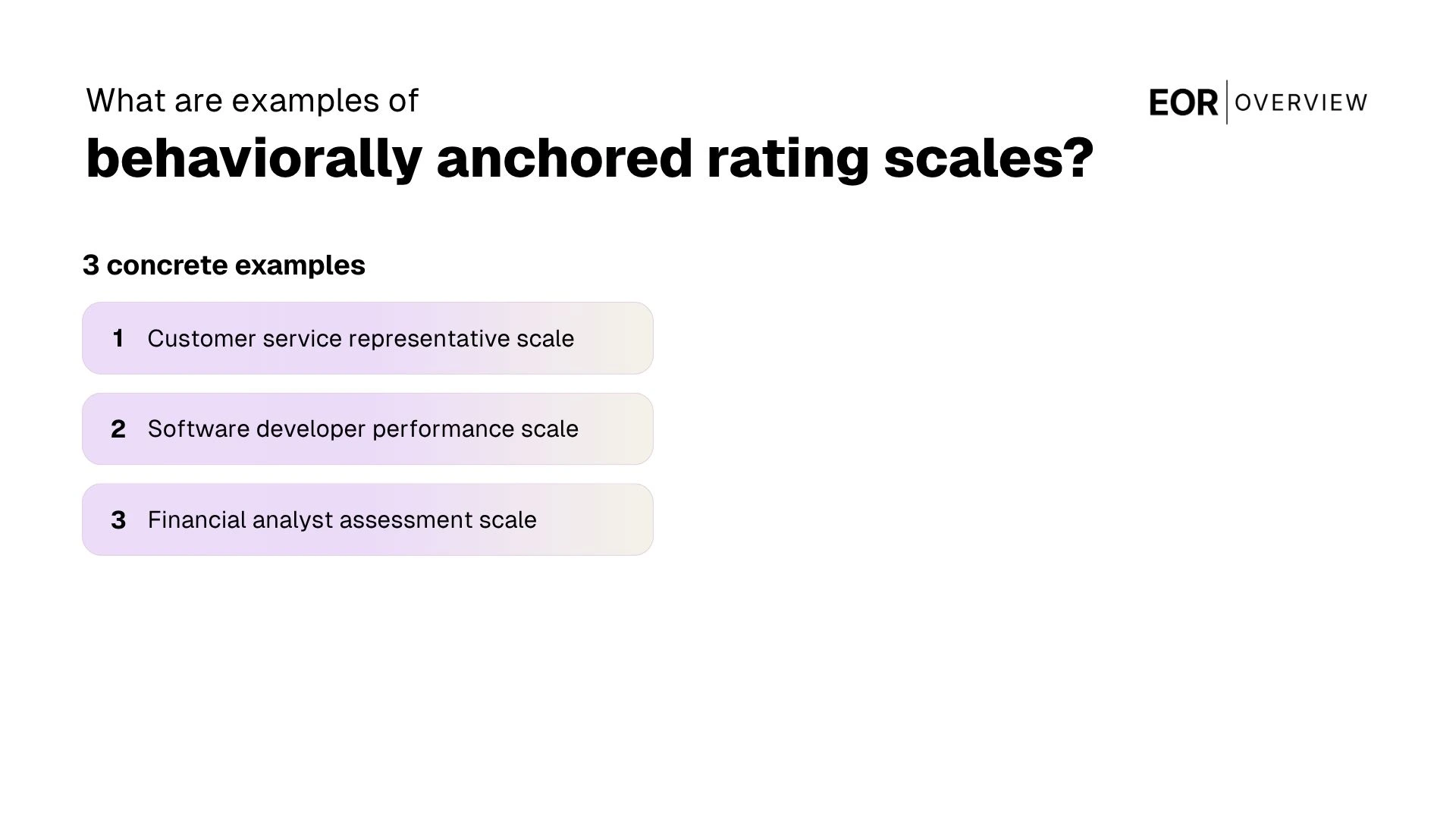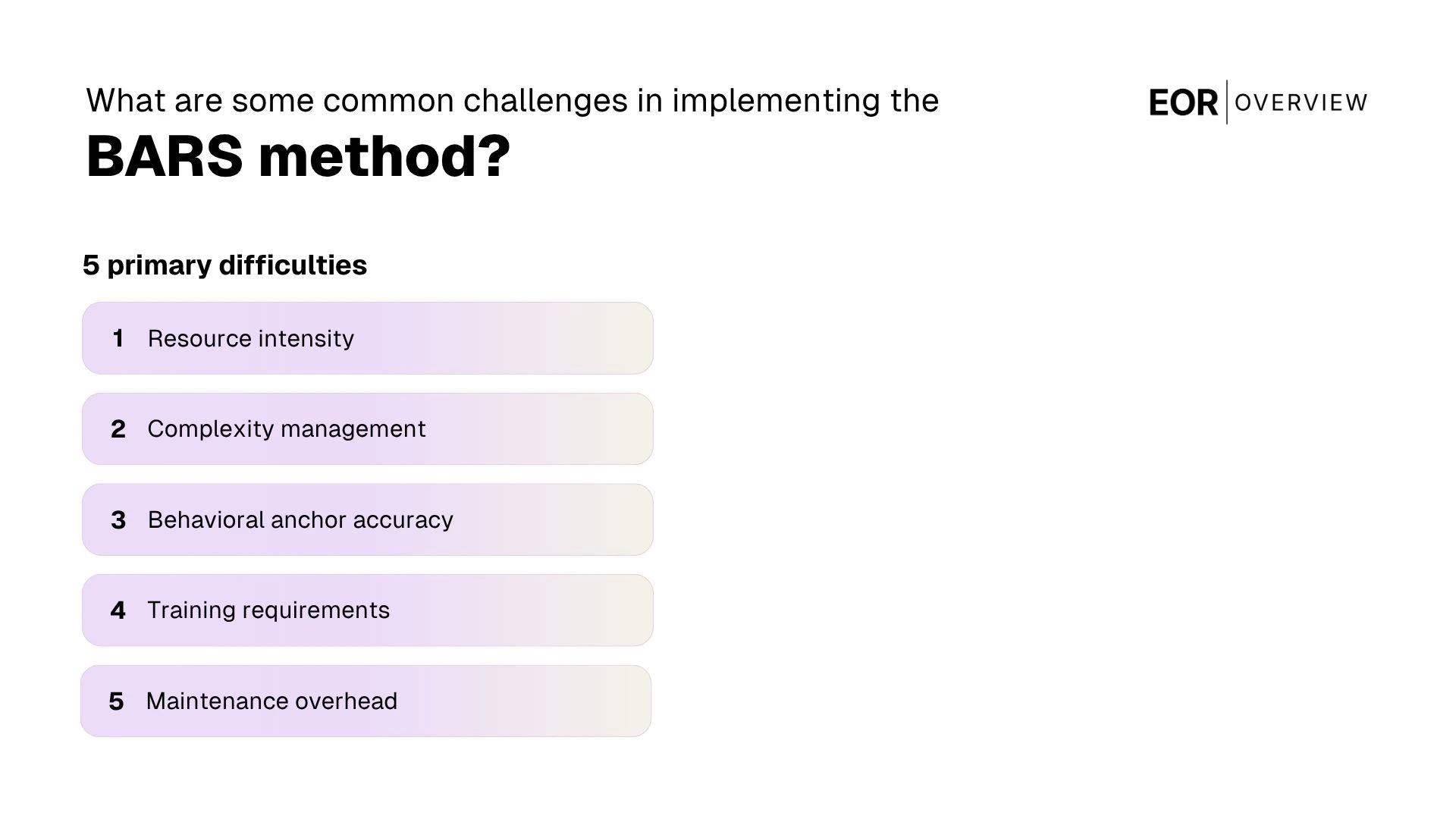Behaviorally anchored rating scales (BARS) is a performance evaluation method that combines the benefits of narrative critical incidents and quantified ratings by anchoring numerical scores to specific behavioral examples relevant to each job role.
For HR and hiring managers in fast-paced tech, finance, and startup environments, BARS transforms subjective performance discussions into objective, defensible assessments. This method eliminates rating inconsistencies between managers, reduces legal risks, and provides employees with crystal-clear expectations and actionable feedback that drives real performance improvements.
Organizations using structured behavioral rating systems report significantly higher employee satisfaction with performance reviews and more consistent talent development outcomes compared to traditional rating methods.
What is behaviorally anchored rating scales (BARS) method?
The behaviorally anchored rating scale is a performance appraisal method that combines the benefits of narrative critical incidents and quantified ratings by anchoring a quantified scale with specific behavioral examples of varying performance levels. This approach transforms traditional performance management by providing concrete, observable behaviors that define each performance dimension rather than relying on vague descriptors.
Unlike conventional appraisal systems that use generic terms like 'excellent' or 'poor,' the BARS method creates detailed behavioral anchors for each performance level. For example, instead of rating communication skills on a simple 1-5 scale, BARS would describe specific behaviors like 'consistently provides clear, timely updates to team members and stakeholders' for high performance or 'frequently fails to communicate project status, causing confusion' for low performance.
This evaluation approach significantly reduces subjectivity in employee performance assessments by giving HR managers and supervisors concrete examples to reference during the appraisal process. The method requires substantial upfront investment to develop the behavioral anchors, but delivers more accurate and defensible performance evaluations that employees can better understand and act upon.
How does the BARS method compare to other performance appraisal methods?
The BARS method stands out from traditional performance evaluation approaches by combining the precision of quantitative ratings with the depth of qualitative behavioral descriptions. Unlike generic rating scales that rely on vague terms like 'excellent' or 'poor,' using BARS provides specific behavioral anchors that clearly define each performance level.
The BARS approach offers enhanced objectivity, behavioral specificity, reduced rating errors, and improved feedback quality compared to traditional rating scales, ranking methods, and narrative evaluations. These distinctions are outlined in detail below.
Traditional rating scales: Generic descriptors create ambiguity, while BARS uses observable behaviors to define each rating point, making performance review discussions more concrete and actionable.
Critical incident method: Focuses only on exceptional events, whereas BARS captures the full spectrum of specific behavior patterns across all performance levels throughout the evaluation period.
Ranking systems: Force employees into predetermined distributions, but BARS allows multiple employees to achieve the same performance level based on demonstrated behavioral anchors.
Narrative evaluations: Rely heavily on supervisor writing skills and can vary widely in quality, while BARS provides structured behavioral examples that any manager can use effectively.
When you develop a behaviorally anchored rating scale, involve high-performing employees in identifying the specific behaviors that define excellence. Their insights ensure your behavioral anchors reflect real-world success patterns rather than theoretical ideals.

What are examples of behaviorally anchored rating scales?
BARS provides concrete examples across different performance levels to help evaluate employee performance more effectively. These examples demonstrate how the bars method transforms abstract performance criteria into specific, observable behaviors that subject matter experts can easily assess during the appraisal process.
Customer service representative scale: BARS may include behaviors ranging from 'consistently interrupts customers and provides incorrect information' (level 1) to 'actively listens, resolves issues on first contact, and follows up proactively' (level 7). This reduces subjectivity in employee evaluation by defining what excellent versus poor service actually looks like.
Software developer performance scale: Different performance levels might span from 'code requires extensive debugging and rarely meets deadlines' (level 2) to 'delivers clean, well-documented code ahead of schedule and mentors junior developers' (level 8). Using the bars method helps tech managers assess both technical skills and collaboration.
Financial analyst assessment scale: BARS requires specific behavioral anchors like 'analysis contains multiple errors and lacks supporting data' (level 1) versus 'provides comprehensive analysis with accurate forecasts and actionable recommendations' (level 9). This approach helps finance teams implement bars successfully by focusing on measurable outcomes rather than subjective impressions.
What are the pros and cons of the BARS method?
The BARS method offers distinct advantages and challenges that hr teams should carefully consider when evaluating their performance management system. Understanding these trade-offs helps organizations make informed decisions about integrating this approach to performance evaluation.
The primary benefits include enhanced objectivity, clearer performance expectations, and reduced rating bias, while the main drawbacks involve significant development time, resource intensity, and maintenance complexity. These factors directly impact how performance management processes function within your organization.
These advantages and disadvantages are detailed below to help you assess whether creating a bars system aligns with your organizational needs.
Enhanced objectivity: Provides specific examples of effective and ineffective behaviors that eliminate guesswork when evaluating employee performance using concrete behavioral anchors.
Clearer performance standards: Establishes precise expectations for each level of performance, helping employees understand exactly what constitutes effective performance in their role.
Resource intensive development: Requires substantial time investment from subject matter experts and HR professionals to identify and validate effective and ineffective behaviors for each performance dimension.
Maintenance complexity: Demands regular updates as job requirements evolve, making it challenging to keep the rating scales current and relevant for ongoing performance evaluations.
What are the alternatives to BARS?
While BARS provides a structured approach to employee appraisal, several alternative evaluation methods can help employees understand performance expectations and improve performance outcomes. These alternatives combine qualitative and quantitative approaches to support organizational goals through different management processes.
Management by objectives (MBO): This evaluation method focuses on setting specific, measurable goals that align with organizational objectives. Employees and managers collaborate to establish targets, making it easier for employees to understand expectations and track progress.
360-degree feedback: This comprehensive approach gathers input from supervisors, peers, subordinates, and customers to provide a holistic view of performance. It captures both specific behavioral observations and broader competency assessments.
Critical incident technique: Similar to BARS' focus on critical behaviors, this method documents significant positive and negative performance events throughout the evaluation period. It requires less extensive job analysis while still providing concrete examples.
Graphic rating scales: These traditional scales evaluate employees on predetermined traits or behaviors using numerical or descriptive ratings. While simpler to implement than BARS, they may lack the behavioral specificity that makes performance feedback actionable.

What are some common challenges in implementing the BARS method?
While the behaviourally anchored rating scale offers significant advantages over a traditional rating scale, implementing the bars method of performance appraisal presents several obstacles that organizations must navigate carefully.
The primary difficulties include resource intensity, complexity management, behavioral anchor accuracy, and ongoing maintenance requirements. These implementation challenges are detailed below.
Resource intensity: Developing a bars requires substantial time investment from HR teams, managers, and subject matter experts to create accurate behavioral anchors for each role.
Complexity management: Unlike a simple rating scale with specific numerical values, bars demands higher levels of empathy and analytical thinking from evaluators to match behaviors with appropriate anchors.
Behavioral anchor accuracy: Creating relevant behaviorally anchored rating scale examples that truly reflect performance levels requires deep understanding of job requirements and observable behaviors.
Training requirements: Managers need comprehensive training to effectively use this rating scale with specific behavioral indicators, which can strain training budgets and schedules.
Maintenance overhead: Regular updates to behavioral anchors are necessary as roles evolve, requiring ongoing investment to help employees improve their performance through accurate assessment.
Who is the BARS approach best for?
The BARS approach works exceptionally well for organizations that need precise performance measurement with clear accountability. This performance appraisal method that combines qualitative observations with quantitative ratings proves most valuable for companies managing complex roles where performance varies significantly across different competencies.
Tech companies and startups benefit tremendously from using behaviorally anchored rating scales because the method provides structure while accommodating rapid role evolution. The BARS system helps hiring managers and HR professionals make informed decisions about promotions by offering specific behavioral examples that eliminate guesswork from performance discussions.
Finance organizations find particular value in how BARS can help standardize evaluations across different departments and regulatory requirements. The method that combines objective measurement with detailed behavioral descriptions creates the documentation necessary for compliance while supporting fair compensation decisions.
Organizations with high-stakes hiring decisions or complex performance management needs discover that BARS provides clear frameworks for evaluating employee performance using BARS. The anchored behaviors and specific examples built into each BARS scale make this approach ideal for companies requiring defensible, consistent performance evaluations.
How to develop a behaviorally anchored rating scale?
Developing bars requires a systematic approach that combines behavioral observation with numerical measurement. The implementation of bars begins with identifying critical performance dimensions specific to each role, then anchoring these dimensions with observable behaviors that correspond to different performance levels.
Start by assembling a team of subject matter experts who understand the role thoroughly. These experts will create performance dimensions that reflect the most important aspects of job performance. Each dimension should represent a distinct area where employees can demonstrate varying levels of competency.
Next, develop behavioral anchors for each performance level on your numerical scale. Most organizations use a rating scale from 0.01 to 10.00, though some prefer shorter ranges. For each scale point, write specific behavioral examples that clearly illustrate what performance looks like at that level. These anchors transform abstract performance concepts into concrete, observable actions.
Test your newly developed performance evaluation tool with a pilot group before full deployment. This reliable method allows you to refine behavioral descriptions and ensure raters can consistently evaluate performance using the anchored behaviors. Since bars combines qualitative behavioral observations with quantitative ratings, proper validation ensures the tool will accurately measure employee performance across your organization.
Remember that BARS requires ongoing maintenance and regular updates to remain effective. As job requirements evolve and your organization grows, revisit your behavioral anchors annually to ensure they reflect current performance standards and business priorities.

